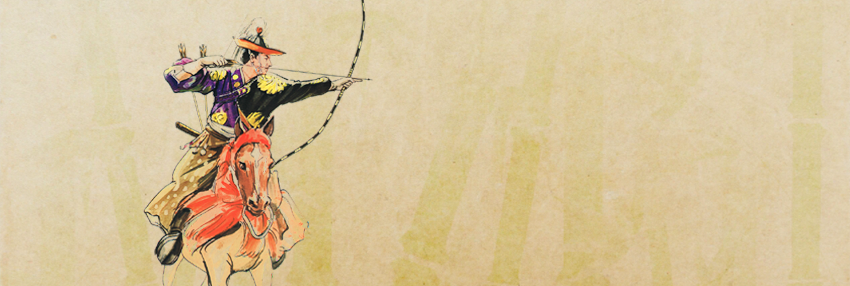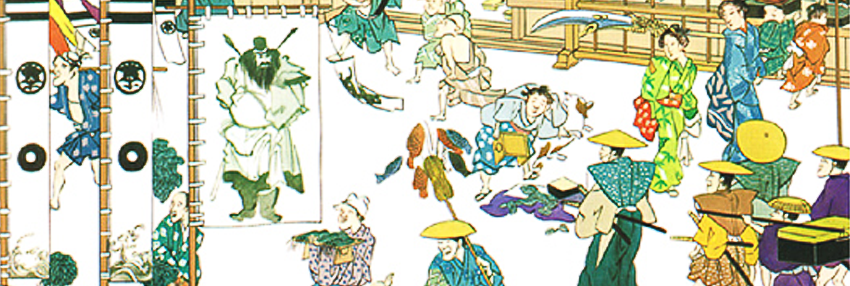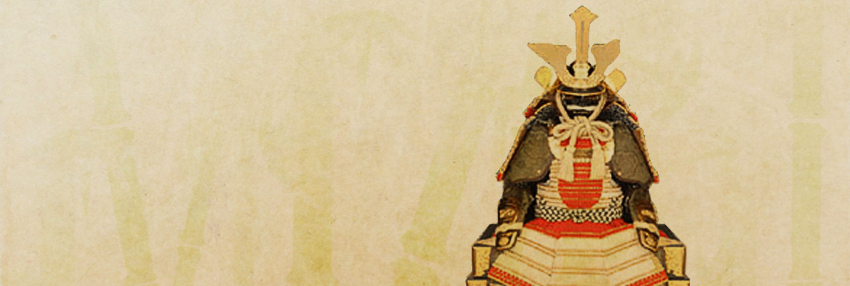History of Armor
History
Tango no Sekku and Mounted Archery

Tango no Sekku is said to be a custom that came from China 1,000 years ago. It appears to have originally been a ceremony to pray for health. Tan (端) means “beginning” and go (午) meant “Day of the Horse,” and is a homonym for the Japanese word for “five,” so the fifth day of the month was designated as Tango no hi (“the first horse day of the fifth month”), and the ceremony was performed not only in May, but in every odd-numbered month.
In The Pillow Book, Sei Shonagon wrote, “There is no day like the fifth of May for seasonal festivals. The appearance that the iris and wormwood are both fragrant is very quaint.” In the Tempyo Era of the ancient Nara Period as well, the Sechie (literally, “fifth day seasonal banquet”) was held in the Imperial Palace. Tango no Sekku eventually became Boys’ Day from around the time when umayumi and yabusame (mounted archery events) began to be held after the banquet as a regular tradition in the Imperial Palace.
From Outside to Inside the Home in the Edo Period

The irises used as decorations for Tango no Sekku symbolized the warrior spirit. Accordingly, the tradition developed further during the Kamakura Period, and from the time of the Tokugawa Shogunate, a solemn ceremony was held as one of the Gosekku, or “five seasonal festivals” (the Seven Grasses Festival on January 7, the Peach Festival on March 3, the Iris Festival on May 5, the Star Festival on July 7, and the Chrysanthemum Festival on September 9). Flags, banners, identification banners, streamers, and other outdoor decorations were used to celebrate the occasion in samurai homes. However, townspeople were prohibited from flying flags, so instead they raised banners decorated with pictures of shoki demon slayers and warriors, and instead of streamers, they devised a koi fish-shaped windsock, providing lively enjoyment for adults and children alike. Eventually, the decorations expanded into the interior of homes as well, and things such as warrior dolls and indoor banners became established as decorative traditions.
As time went on, this traditional event was passed down lavishly as a festival for the healthy growth of boys in every era. In July 1948, the name was changed to “Children’s Day,” and it became a national holiday celebrated on May 5, subsequently becoming even more lavish.
Intelligence, Benevolence, and Courage are Tadayasu's Desires
During the Warring States Period, warlords who possessed wisdom, benevolence, and courage were viewed as the ideal samurai. Wisdom, benevolence, and courage are also the desires of Tadayasu. The desire for others to grow healthily, with the intelligence, benevolence, and courage of a samurai possessing a wise and intelligent mind and a broad heart…We want you to continue shining, like the brilliant sunlight of a day in May. This is also our prayer for the strong growth of your children.
Armor of Japan

In Japan, armor was continually being improved due to the changes in weaponry and the form of war, but it has also maintained its characteristics to a certain degree. However, with the advent of the Meiji Restoration and the resulting elimination of the warrior class and modernization, armor gradually fell out of practical use.
Today, armor is produced as historical art pieces, traditional craftwork, and historical materials.
Even compared to the protective wear of the rest of the world, the armor of Japan is characterized by its rich color and beauty. This is because the samurai were always at the core of power, and because a portion of the higher-class samurai symbolically cherished the armor in the peaceful Edo Period in particular. We produce our products utilizing the forged iron, leather, lacquer ware, metalwork
Copyright © 2021 Tadayasu All Rights Reserved.


